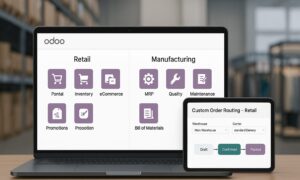This article contains sponsored content.
You have likely come across the term Internet of Things (IoT) at least once during the last few years. With more and more physical devices being connected digitally to the internet and collecting a vast amount of data, it can potentially offer highly valuable feedback for businesses to act and optimise on.
Several companies and industries have taken notice of the potential of IoT as a way to optimise operations and perhaps even offer a source of achieving or sustaining competitive advantages. One such element of the global chain is the manufacturers. In this article, we will explore how IoT currently is and will continue to transform the manufacturing industry.
Why manufacturers look towards IoT to stay competitive
IoT adoption in the manufacturing sector is on the rise and for a good reason. With higher demands for customisation, output quality and quantity as well as the growing complexity of operations, many manufacturers are being pushed towards looking for new and innovative ways to respond to the emerging challenges and stay on top of the competition.
With the latest developments in IoT solutions for manufacturing, it is hard for companies to ignore the potential benefits of further digitalisation in their operations. Some of the key drivers behind adopting IoT and its applications in the manufacturing sector include:
1) Improvements to management and control
IoT tracking provides real-time feedback for employees to facilitate improved decision-making based on accurate information regarding applications such as inventory levels, raw material requirements and equipment utilisation. IoT can also provide supply chain managers with improved cross-channel visibility to stay fully informed about various input and output flows.
2) Streamlining operational costs
IoT allows manufacturers to schedule predictive maintenance to minimise downtime – one of the key sources of operational expenses. The data insights provided by IoT can also help schedule staff requirements, optimise energy use and lower inventory carrying costs due to improved inventory management.
3) Improve worker safety
IoT can provides useful assistance for monitoring safety levels. With sensors and wearable devices being used for monitoring machine and employee conditions, managers can take further action towards providing a safer working environment and reduce the risk of accidents by collecting relevant environmental and worker data.
4) Positive impact towards better customer satisfaction
There is an increase demand from customers for a high level of customisation. IoT devices create multiple improvements in supporting manufacturers maintain a high quality without impacting quantity output and price, keeping customer satisfaction high. For example, connected devices can help to prevent human error, or even identify defective products and materials from working their way down the supply chain.
Summary
What does the future of IoT in manufacturing look like? It is clear that the numerous applications and benefits of IoT solutions in manufacturing will and are already transforming the large-scale operations of the sector to serve both the manufacturers and their customers. Successful implementation and utilization of IoT in the manufacturing industry is also likely to play a key role in determining future winners and losers of companies.



































